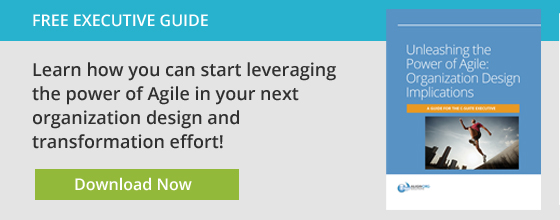To fully benefit from an Agile organization design effort, you need effective teams and means of engaging stakeholders and customers. True to Agile principles, your team should be customer-centric, flexible enough to respond to market changes, and capable of producing design “products” that you can test and implement immediately. But, what does an Agile organization design team look like? What other roles are needed to support the Agile journey? How can you produce organization designs that can be tested and used immediately? And, how do you sustain momentum?
Determining Your Organization Design Team Roles
There are many similarities between how we structure Agile organization design sessions (sprints) and Scrum, a popular Agile technique. Scrum outlines three different roles for work sprints: Product Manager, Scrum Master, and Team Member. In the broadest sense, Product Managers determine the focus of the team, Scrum Masters facilitate meetings and guide the team’s work, and team members do the work.
We advocate something very similar for design sessions. Each member of a design session has a role to play. While the Alignment Leader (a.k.a. the sponsor or “Product Manager”) provides strategic guidance and the final say in the case of a tie, a design facilitator plays a comparable role to the Scrum Master as the team works together to determine how they will develop the organization design “product.”
Role details include:
- Sponsor (Product Manager) – An Alignment Leader who defines the vision of where the organization needs to go. They help secure the organizational resources needed to undertake the alignment work, and they ensure alignment between the team’s work product and the enterprise vision for the organization. Sponsors can participate in certain aspects of the team’s work, but they rarely come with the answer. Instead, they trust the team to understand the best ways for the organization to achieve alignment and then create the conditions where stakeholders in the business can understand the team’s recommendations.
- Change Partner (the Design Facilitator similar to a Scrum Master) – A specialist in organization design and change who brings tools and methodologies to help the team work through the alignment questions that need to be addressed. They assertively facilitate the team’s work sessions, adeptly guide the team through the design sequence/flow, and challenge the entrenched thinking of the team as they consider design options.
- Design Team –
 A cross-functional group that considers stakeholder feedback (the outside-in voices of stakeholders) and weighs organization alignment decisions in the context of the various organizing systems of the organization.
A cross-functional group that considers stakeholder feedback (the outside-in voices of stakeholders) and weighs organization alignment decisions in the context of the various organizing systems of the organization.
Now that we understand the roles of participants, how do you find the right people for the job?
Building Your Agile Organization Design Team
Thinking systemically towards implementing organization change can be difficult for teams at first. It requires contextualizing choices against other organizational systems, simultaneous efforts, and broader enterprise and strategic goals. To be effective, teams must align their choices to every side of the organizational cube to ensure proper strategic and organizational alignment.
The first step to assembling the right team is knowing where to look. Members of design teams should be natural change agents, early adopters, and strong influencers for the organization. You might also consider utilizing the experience as a development opportunity for high-potential individuals.
Additionally, design sessions are powerful opportunities to help those potentially resistant to the change. Through the design session, these less-ready adopters have a chance to voice their opinions, work through the rationale for the change, and ultimately create greater buy-in through their participation and “investment” into the organization design “product.”
Generally, look for individuals that:
- Exhibit strategic thinking and high learning agility
- Can focus on a new direction, change directions quickly, and can work iteratively
- Push performance and constantly reach for higher goals in their job/department
- Communicate effectively, offer fresh perspectives, and are willing to concede to group consensus after healthy deliberation
- Can step back from their personal perspectives and see an organization from the enterprise level
- Can put the best interest of the company before their own even if it impacts their own role
We advocate that each design session should be cross-functional and usually will not involve the same individuals throughout the journey. Each step (or product) may benefit from a different mix of individuals with unique expertise and views into the organization. Overall, this broad involvement ensures a more balanced and holistic design and garners significant buy-in for the organization design.
Most design teams are relatively small (6-10 people). Too many people can slow decision making and be less productive. However, large teams can also produce amazing results and alignment if properly managed and broken into smaller groups during sprints (Rarely is 80 people working in one group effective, but breaking 80 people into smaller groups in the same room and sharing out together can be powerful). Regardless of the size, make sure that you have sufficient expertise, skills, and representation to be able the team to make decisions and garner organizational support.
How Agile Roles Evolve With the Project
After a team has created a solution, trusted customers and stakeholders also have a role in reviewing and approving the product. This would be the equivalent to “test and learn” in software development. Customers and stakeholders offer valuable feedback and can help further refine and improve the final design.
The faster and more immediately design choices can be vetted, the faster implementation can happen. Too many organizations on the road to transformation drag the change out waiting for the perfect answer or waiting for all the “i’s” to be dotted and “t’s” to be crossed. An Agile transformation is different – design, test, learn, and implement.
Because design sessions cascade through the organization and are cross-functional, the momentum for change picks up. Those involved in designing can play a key role in implementing (or at least in helping share the benefits and vision for the new ways of working). The work of an Alignment Leader (the Product Manager) becomes even more critical as the new ways of working or the design products are implemented. This individual will signal to the organization why change is needed, and address expectations about what needs to change and how to be successful. When things get tough (as they most certainly will), Alignment Leaders and Change Partners put their heads together and find a path forward. Making the change stick is the key to taking the Agile transformation from the drawing board into the culture of the organization.
Putting It All In Place
Successful teams include a combination of the right people, a strong Alignment Leader, a clear vision, and intuitive tools and processes. With these in place, teams can produce the best design choices for implementing organization change that reimagine how an organization will deliver value and produce results in a quick, iterative, and Agile way.






